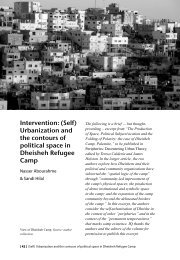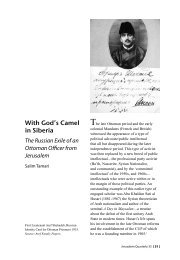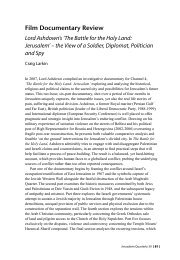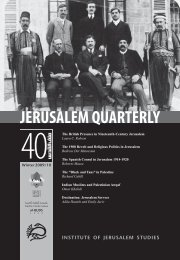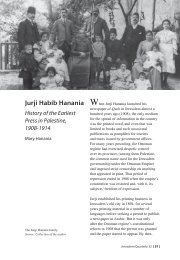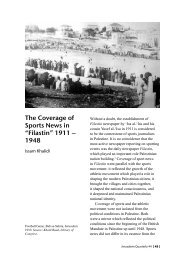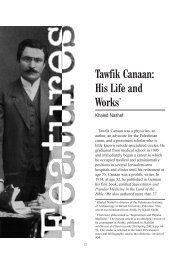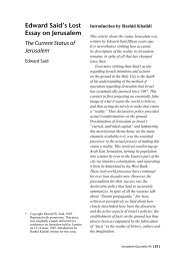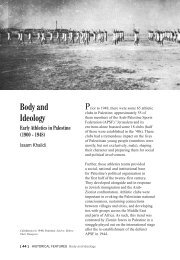PLUNDERING PALESTINE - Jerusalem Quarterly
PLUNDERING PALESTINE - Jerusalem Quarterly
PLUNDERING PALESTINE - Jerusalem Quarterly
Create successful ePaper yourself
Turn your PDF publications into a flip-book with our unique Google optimized e-Paper software.
However, party-goers, clubbers and boutique shoppers were in luck in 2007:<br />
Time Out <strong>Jerusalem</strong>, a monthly guide, came to present us with a new and better<br />
<strong>Jerusalem</strong>, one where restaurant ratings triumph over building demolitions, and “hip<br />
cafes, happening bars and designer boutiques” form a “Trendy <strong>Jerusalem</strong>” (March<br />
2007) that has no trace of <strong>Jerusalem</strong>’s recent history, where such cafes were truly<br />
sites of danger. <strong>Jerusalem</strong> is no longer contested, bitter, or even bounded by the Wall<br />
– <strong>Jerusalem</strong>, it turns out, is a party city and destination of choice for youthful and<br />
affluent tourists.<br />
Time Out <strong>Jerusalem</strong> (and Time Out Tel Aviv) are monthly publications of an Israeli<br />
company, the Yuval Sigler Media Group, under “exclusive license” from the UKbased<br />
Time Out International – although, perhaps because of low demand or a<br />
sense of discretion, these editions are not listed on Time Out’s main website 2 ,<br />
which does include Time Out Dubai and Time Out Abu Dhabi. All issues of Time<br />
Out <strong>Jerusalem</strong> to date contain the same potted history of <strong>Jerusalem</strong> (“In Context”),<br />
noting, indisputably, that the 5,000 year history is “fraught with turmoil, conflict and<br />
bloodshed.” A laundry list of conquerors follows, with Israel’s capture of the city in<br />
1967 noted simply: “to this day the city remains under Israeli government.” Indeed,<br />
except for a brief mention of the Israeli-Palestinian Declaration of Principles in<br />
1993, the 1967 war seems to have brought <strong>Jerusalem</strong>’s history to an end, leaving the<br />
way open for more familiar ground, i.e. where to find the best bars and restaurants,<br />
boutiques, clubs and a scattering of cultural events. A comparison with an equally<br />
brief, but more honest, history of <strong>Jerusalem</strong> in the UK-based Rough Guide series is<br />
telling. Noting Israel’s “unilateral” annexation of <strong>Jerusalem</strong>, the Guide points out<br />
that “most of the international community does not recognize Israel’s jurisdiction<br />
over East <strong>Jerusalem</strong>” and adds that Israel has “ringed East <strong>Jerusalem</strong> with three<br />
bands of settlements to forestall the Palestinian claim to the east.” 3<br />
The magazine’s brief foray into history is more unrevealing than directly<br />
objectionable; it’s shaping of the new <strong>Jerusalem</strong> comes more through the heart of<br />
the matter – what to buy, where to go, what to see, what is happening. It is in these<br />
“cartographies of leisure,” to use Stein’s apt term, that we discover how “Things<br />
are happening in <strong>Jerusalem</strong>, a multi-cultural melting pot”. Lest the reader imagine<br />
that the guide is about to introduce <strong>Jerusalem</strong>’s diverse populations, identities<br />
and cultures, “The Melting Pot” section in December 2006 included “European<br />
decadence,” (a waffle shop), a spice and nut haven in Maoz Zion (“colloquially<br />
know as the Castel”) and a suggested trip to “fab wineries” in the Judean Hills (“you<br />
don’t have to go all the way to Tuscany”). A click on the suggested map route shows<br />
a stop at that Tuscan-like Israeli settlement, Gush Etzion.<br />
<strong>Jerusalem</strong> <strong>Quarterly</strong> 33 [ 77 ]



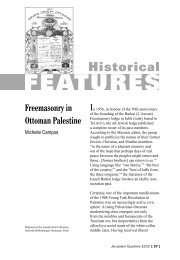
![In Search of Jerusalem Airport [pdf] - Jerusalem Quarterly](https://img.yumpu.com/49007736/1/180x260/in-search-of-jerusalem-airport-pdf-jerusalem-quarterly.jpg?quality=85)
